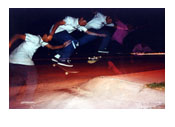
Stroboscopic photography uses flash bursts from a flash to produce a continuously
moving subject into an overlapping sequence of frozen images. Stroboscopic
photography can produce an intriguing pattern of shapes, or a scientific
analysis of movement against time. Stroboscopic photography has become
popular in skateboarding magazines in the last few years.
It is impossible to tell you exactly what aperture and f-stop to use,
but I have found that I achieve the best exposures when I meter the scenes
available light, and find an acceptable f-stop and shutter speed combination.
Then I determine how bright of a flash burst I will need to expose the
moving subject. Finally I take into consideration how many frozen images
I want to be in the final image.For example, when I metered the picture
below I determined that I would need to expose the scene at two seconds
at f2.8 to pick up the sidewalk and the skyline. I then set my camera mounted
flash to fire at 1/4 of the flashes power to properly expose the skateboarder.
I then took into consideration that I only wanted about 5 frozen
images of the skater in the image. Therefore my final exposure was set
at F2.8 at 2 seconds with my flash set to fire 5 burst of 1/4 its maximum
power. Note that when I am taking these pictures that my camera is always
fastened to a secure and stable tripod, and that I am using a shutter release
cord. If you do not take these steps to ensure minimal camera shake,
then your image may turn out streaked or blurry.
The camera I use is an Eos-1n and the flash I use is a 540EZ. These
are the tips that Canon suggests when shooting stroboscopic images. Set
the shutter speed calculated from the following formula: No. Bursts divided
by the firing frequency. The problem with this is that it doesn't take
into account the fact that one may need to expose for a background as well
as the foreground. In this case, simply make sure the camera is secure
from camera shake and turn up the shutter speed.
Again use this information as a starting point and remember that the
number and frequency of flashes you will need depend on the subject, the
speed of the action, and the degree of clarity you require. A slow ballet
movement may look best with eight flashes over a 10 second period, but
a faster tennis strok may need as many as 20 flashes in 1.5 seconds. Also,
if you don't have the money to buy a flash that has this capability, you
can try hand holding your flash and manually firing the test flash button
as fast as you can.
